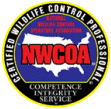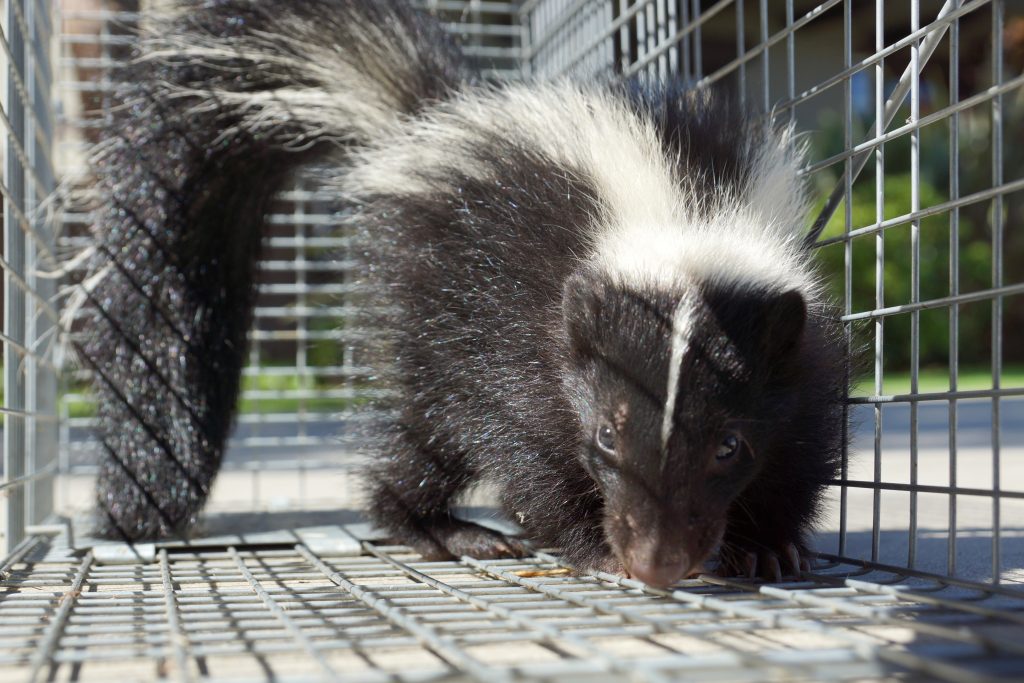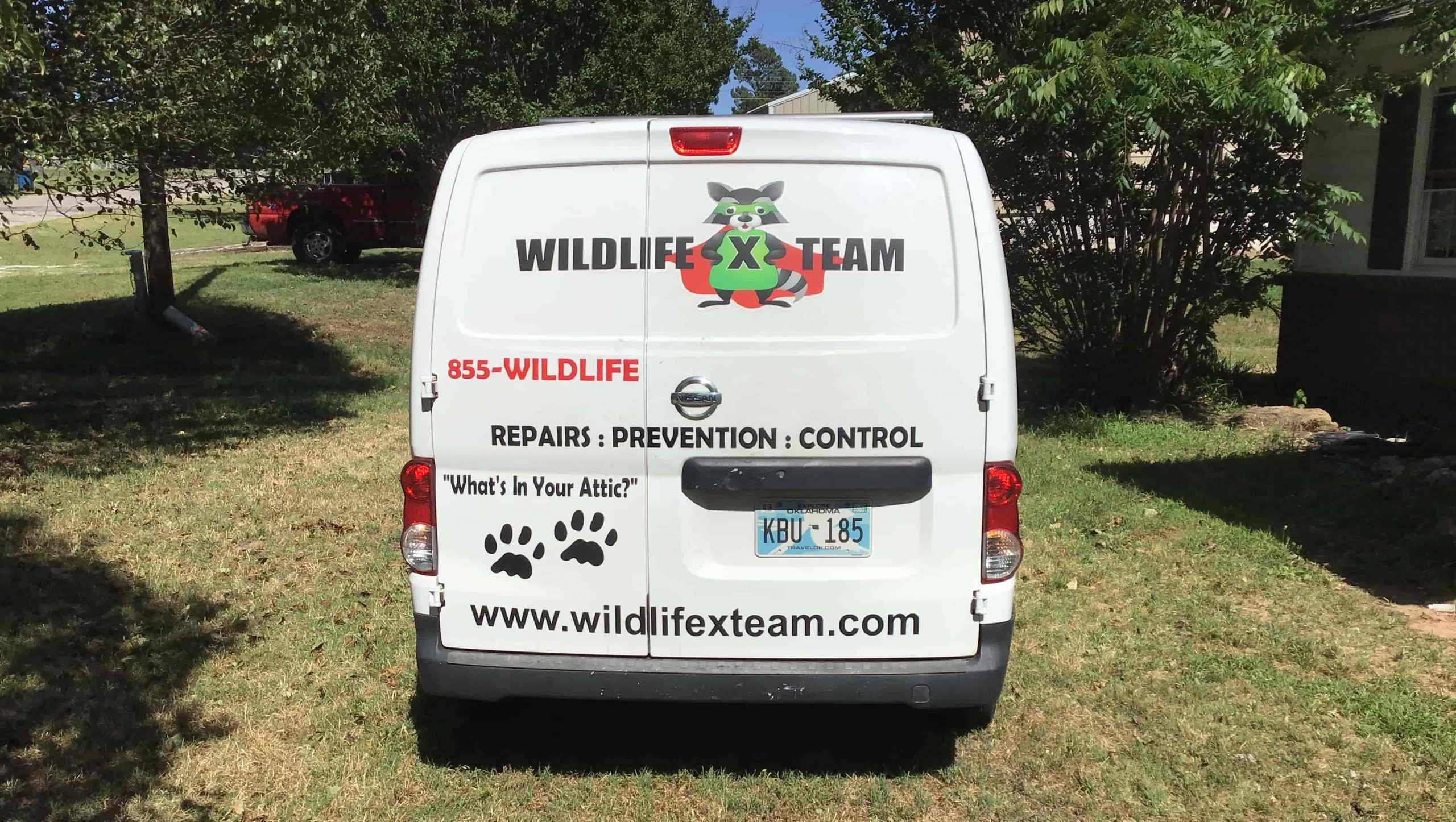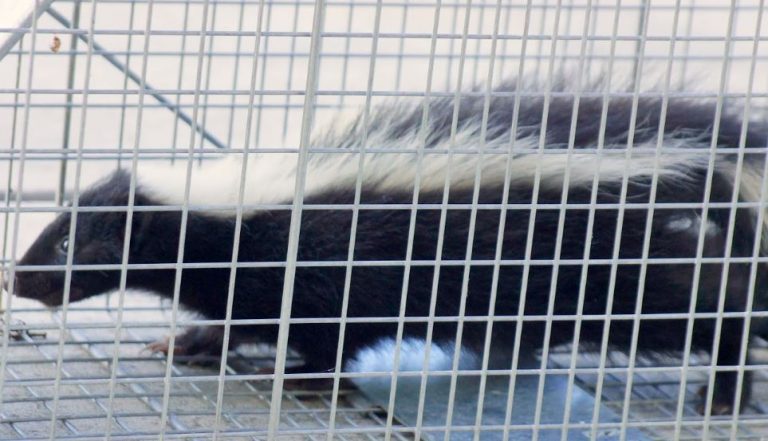
Call for Your Exclusive Wildlife Inspection Report.®
Skunk Removal
Although skunks are beneficial to our yards (they feed on harmful pests), their presence is unwelcomed because of their terrible odor, as well as their penchant for digging. When threatened, they spray a mixture of sulfur-containing chemicals, such as thiols, which gives off an offensive odor.
For homeowners in Tulsa, here are some of the most common problems caused by skunks.
- Skunks residing under the crawlspaces like under the porch, shed, or deck.
- Spraying in your yard, which releases a noisome odor.
- Digging holes in the yard in search of grubs
- Threatening household pets with their spray.
- Damaging the garden… and more.
- Health concerns including leptospirosis, rabies, intestinal roundworm, and more.
Experts at Wildlife X Team Tulsa can help you solve your skunk problem.
Skunk Removal Process
The best way to get rid of skunks is through an integrated control plan that incorporates both removal and deterrence. Here’s how we go about it at Wildlife X Team Tulsa.
Eliminate Food and Shelter
Skunks are in your yard either because it provides them food or shelter or both. Here are some actions you can take:
- Ensure you properly close your garbage.
- Do not leave fallen berries, fruits, and seeds in the yard.
- Eliminate woodpiles, hollowed wood, and other debris that can shelter them.
- Close off access to barns, poultry houses, and sheds.
Inspection
The purpose of an inspection is to identify the areas of damages. This helps to determine the best control method to implement.
Control Methods
Here are some of the most effective skunk control options.
Live Traps
A live trap is well-suited for capturing skunks that are residing in your yard. The reason it’s a great option is that you do not need to get close to the skunk to capture it. Some of the best baits to use include fish and chicken.
Once the trap captures the skunk, approach the trap slowly and place a large towel over it. Skunks do not like to spray targets they cannot see, so this ensures that you do not get sprayed After trapping, the animal should be relocated to, at least, 10 miles from the capture site.
Get Quote for Your Exclusive Wildlife Inspection Report.®



If the animal is residing under your crawlspace, you have to ensure that there are no babies there before you capture and relocate the skunk. Since skunk trapping and relocation is subject to state law, it’s best to use the services of professionals like Wildlife X Team Tulsa.
Repellents
There are several skunk repellents on the market but they are not very effective. Provided there’s still access to food or shelter, skunks will generally put up with the inconveniences they cause.
Fencing
Fencing is a good but expensive way to keep skunks out of your yard. Since skunks are not great climbers, the fence just needs to be about 4 feet tall. However, since they’re great diggers, the fence needs to be about 1 – 2 feet below ground level.
Call for Your Exclusive Wildlife Inspection Report.®

How to Remove Skunks Under Porch
Skunks are actually less scary than most of us seem to think. While many people are – rightfully – scared of coming into contact with the infamous skunk spray, it’s worth noting that skunks are actually fairly non-aggressive creatures. This is why they’ve created that stinky spray of theirs, as a way of preventing a fight, not to initiate one.
So rather than wanting to confront you, a skunk would much rather scamper off, without engaging in a fight. In many ways, skunks can actually be beneficial for the environment they inhabit. However, having one (or an entire family) taking up residence in your yard, or under your porch, can have quite a few downsides.
So here’s how you may remove skunks from under the porch safely and humanely.
- Cut off what’s attracting them.
Skunks, like most other wild animals, are simply coming to your yard because they’ve discovered an easy source of food or water. It’s not that complicated. So simply cutting off that source can go a long way in convincing skunks to leave your yard alone.
Common skunk food sources include exposed trash cans, pet food and water bowls, ponds, bird feeders, birdbaths, and so on. So simply bringing that inside, covering them, or removing them altogether may go a long way in cutting down the skunk population.
- Use apple cider vinegar.
Funnily enough, a good way to keep skunks away is, ironically, through strong scents. This is where apple cider vinegar can be particularly useful. By soaking cotton balls into the stuff, or even filling a plastic bag with vinegar, and placing either in the space under your porch, you’re creating an unpleasant odor that skunks are unlikely to want to live in.
However, if you do opt for this method, you will want to replace the cotton balls/vinegar bag regularly, to maintain potency.
- Or ammonia (mothballs).
Ammonia repellents work similarly to apple cider vinegar. They’re also the source of a deeply potent and highly unpleasant smell that skunks will find offensive, and that will determine them to leave. You can place mothballs in the space under the porch, to make the area unpleasant for skunks.
- Or kitty litter.
Kitty litter, like the earlier options we’ve explored, emits a mildly unpleasant odor that will put off skunks, and convince them to leave. Careful though, if you are pouring the kitty litter in the space under the porch while the skunk is inside, do only pour on one side, so as to allow the skunk space to leave.
- Try predator urine.
Most animals know to detect the presence of a common predator and steer clear, and skunks are no different. You can either get a big dog, in which case, you may automatically get the benefits of predator urine or else purchase it from a specialty store.
You can readily find fox or bobcat urine online, precisely for this purpose.
- Try repellents.
Also at specialty stores, you might want to shop for a motion-activated device that emits either light or an ultrasonic sound. Both of these will make your property undesirable for the skunks, and determine them to move on.
Alternatively, some homeowners prefer motion-activated sprinklers, since skunks don’t enjoy being pelted with water at random any more than you do.
- Hire a professional.
Last but not least, if you haven’t been able to determine the skunk to leave naturally, it may be time to hire a professional wildlife removal expert. Not only will they get rid of the skunk humanely, but they will also fix the damage caused by the animal, and instruct you on future prevention measures.

How to Remove Skunks Under Porch
Skunks are actually less scary than most of us seem to think. While many people are – rightfully – scared of coming into contact with the infamous skunk spray, it’s worth noting that skunks are actually fairly non-aggressive creatures. This is why they’ve created that stinky spray of theirs, as a way of preventing a fight, not to initiate one.
So rather than wanting to confront you, a skunk would much rather scamper off, without engaging in a fight. In many ways, skunks can actually be beneficial for the environment they inhabit. However, having one (or an entire family) taking up residence in your yard, or under your porch, can have quite a few downsides.
So here’s how you may remove skunks from under the porch safely and humanely.
- Cut off what’s attracting them.
Skunks, like most other wild animals, are simply coming to your yard because they’ve discovered an easy source of food or water. It’s not that complicated. So simply cutting off that source can go a long way in convincing skunks to leave your yard alone.
Common skunk food sources include exposed trash cans, pet food and water bowls, ponds, bird feeders, birdbaths, and so on. So simply bringing that inside, covering them, or removing them altogether may go a long way in cutting down the skunk population.
- Use apple cider vinegar.
Funnily enough, a good way to keep skunks away is, ironically, through strong scents. This is where apple cider vinegar can be particularly useful. By soaking cotton balls into the stuff, or even filling a plastic bag with vinegar, and placing either in the space under your porch, you’re creating an unpleasant odor that skunks are unlikely to want to live in.
However, if you do opt for this method, you will want to replace the cotton balls/vinegar bag regularly, to maintain potency.
- Or ammonia (mothballs).
Ammonia repellents work similarly to apple cider vinegar. They’re also the source of a deeply potent and highly unpleasant smell that skunks will find offensive, and that will determine them to leave. You can place mothballs in the space under the porch, to make the area unpleasant for skunks.
- Or kitty litter.
Kitty litter, like the earlier options we’ve explored, emits a mildly unpleasant odor that will put off skunks, and convince them to leave. Careful though, if you are pouring the kitty litter in the space under the porch while the skunk is inside, do only pour on one side, so as to allow the skunk space to leave.
- Try predator urine.
Most animals know to detect the presence of a common predator and steer clear, and skunks are no different. You can either get a big dog, in which case, you may automatically get the benefits of predator urine or else purchase it from a specialty store.
You can readily find fox or bobcat urine online, precisely for this purpose.
- Try repellents.
Also at specialty stores, you might want to shop for a motion-activated device that emits either light or an ultrasonic sound. Both of these will make your property undesirable for the skunks, and determine them to move on.
Alternatively, some homeowners prefer motion-activated sprinklers, since skunks don’t enjoy being pelted with water at random any more than you do.
- Hire a professional.
Last but not least, if you haven’t been able to determine the skunk to leave naturally, it may be time to hire a professional wildlife removal expert. Not only will they get rid of the skunk humanely, but they will also fix the damage caused by the animal, and instruct you on future prevention measures.


